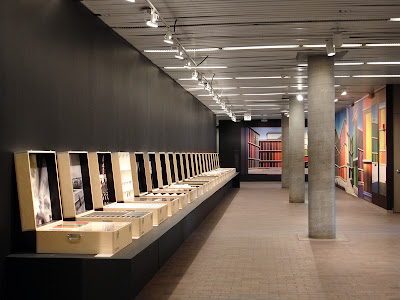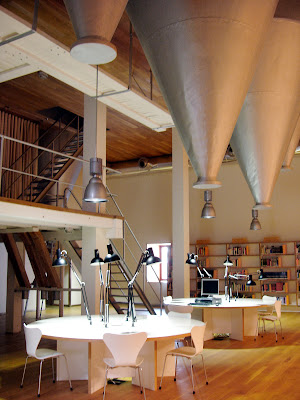It was really sad to learn that Luis Mansilla had passed away. In my opinion, he was one of the rare geniuses of out time. His work offered the architectural world a fresh breeze of mixed simplicity and diversity, in terms of both form making and materiality.
The first time I heard about Mansilla+Tuñón was when I saw drawings of the Villa 08 in Nanjing. I was deeply impressed by the fluid and elegant form, and the smart way to achieve ambiguity between the inside and the outside - something oriental and very suitable for the site.
 |
| Plan, Villa 08 in Nanjing (2003) |
But the first real encounter was when they taught at the GSD in the spring of 2006. Along with the studio, they put up an exhibition in the lobby of Gund Hall. Titled “Playgrounds,” the show displayed their smart playfulness in full power. It was the first time I could systematically learn about their body of work, which they summarized with a beautiful graph. On one side, the projects were (literally) showcased in wooden cases. On the other, full height images gave the visitors an immersive experience. As it was meant to be a traveling exhibition, the cases made perfect sense, especially when I saw them pack the things back for transportation.
 |
| Each project is a showcase. |
 |
| Madrid Regional Government Archives and Library |
 |
| Public Library in Jerez |
 |
| History Museum in La Coruña |
 |
| Cantabria Museum |
 |
| Gran Slam Sports Complex, Madrid |
 |
| Cross Construction, Teruel |
 |
| Villa 08 in Nanjing |
 |
| Cases make sense for transportation |
In the summer of 2007, I traveled in Spain. Out of admiration and respect, I put three of the M+T buildings in my itinerary. It was really because of them that I made a detour to León. In Madrid, I visited the Madrid Regional Government Archives and Library, which was built in the former El Águila brewery. The driving force for the arrangement was the construction of voids and interfaces between the old and new buildings. Simple yet refined materials put the two in perfect harmony.
 |
| Madrid Regional Government Archives and Library (1996-2002) |
León Auditorium is probably one of the most famous of their early work. On the facade, two diverse orders appear: the perimeter of the apertures reflect the geometrical logic of the construction, and the inner aperture of each window follows the requirements of the interior. As M+T puts it, “the constructed plane thus oscillates between a group of stacked windows that are equal in their being and different in their form of being.”
 |
| León Auditorium (1994-2002) |
In Mansilla+Tuñón’s work, they’ve been always interested in equality and difference, like the family of skylights in the Zamora Museum and the family of windows in the León Auditorium. In MUSAC, it materializes as the different spatial experiences within a simple gridded plan. M+T: “This is an art centre that constructs a set of chessboards on which the action becomes the protagonist of the space; a structure that develops from an open system, formed by a fabric of squares and rhombi, allowing the construction of a secret geography of memory.”
 |
| Plan, MUSAC (2001-04) |
Outside, the public space takes on a concave shape to hold activities and meetings. It is surrounded by large pieces of colored glass that take an abstract reference to the stained glass windows in the city’s Cathedral.
The last encounter was a lecture he gave at Columbia University in New York on February 3, 2010. Luis Mansilla talked about the design of MUSAC through six lenses: personal (the concerns we have as human beings, whether we are architects or not), intellectual (the concerns that architects have), geometric/material, historical, artistic/social, and natural. He spoke slowly, like a kind, humble and wise man, telling behind-the-scene stories and making funny analogies.
 |
| Lecture “MUSAC, Six Landscapes” |
Here are some quotes I picked up from my notes:
- Light is the cheapest material in architecture.
- Architecture is impure art. We have ideas, but we still need to deal with reality, budgets, clients, regulations... Sooner or later, contradictions would appear. The intellectual pleasure of architecture is to deal with these contradictions.
- Keep a distance from things and be surprised by the results. Like the colors on the MUSAC facade, they don’t belong to us. (Hands-off process?)
- The most interesting and difficult things in architecture: the first one is to have an idea, and the second is to make it invisible in order to free up space for the others.
- Sometimes when we explain things, we need metaphors. But we don’t believe you can build architecture with metaphors.
- Imagine you are a gardener who plants ideas. Some flowers cannot resist water and decay, some have had too much sun and become dry. At the end you have one that can resist all that and you just take it. It’s nice to see something flows ahead and is able to receive different concerns like a vase.
Following his own metaphor, I think Luis Mansilla himself was truly a constant gardener - not just to dig, but to cultivate. His contribution to architecture was immense. His sudden death was a big loss to the architectural community, and the design community in general.
























No comments:
Post a Comment